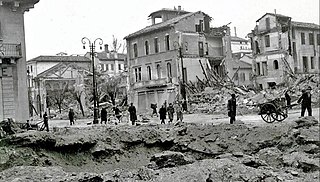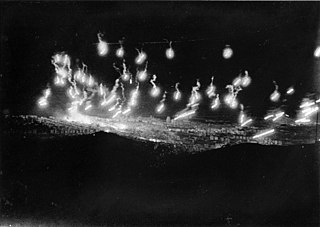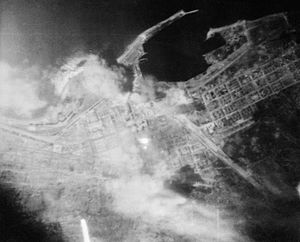
The Allied invasion of Sicily, also known as the Battle of Sicily and Operation Husky, was a major campaign of World War II in which the Allied forces invaded the island of Sicily in July 1943 and took it from the Axis powers. It began with a large amphibious and airborne operation, followed by a six-week land campaign, and initiated the Italian campaign.

Operation Corkscrew was the codename for the Allied invasion of the Italian island of Pantelleria on 11 June 1943, prior to the Allied invasion of Sicily, during the Second World War. There had been an early plan to occupy the island in late 1940, but it was aborted when the Luftwaffe strengthened the Axis air strength in the region.

World War II (1939–1945) involved sustained strategic bombing of railways, harbours, cities, workers' and civilian housing, and industrial districts in enemy territory. Strategic bombing as a military strategy is distinct both from close air support of ground forces and from tactical air power. During World War II, many military strategists of air power believed that air forces could win major victories by attacking industrial and political infrastructure, rather than purely military targets. Strategic bombing often involved bombing areas inhabited by civilians, and some campaigns were deliberately designed to target civilian populations in order to terrorize them and disrupt their usual activities. International law at the outset of World War II did not specifically forbid the aerial bombardment of cities – despite the prior occurrence of such bombing during World War I (1914–1918), the Spanish Civil War (1936–1939), and the Second Sino-Japanese War (1937–1945).
Operation Husky order of battle is a listing of the significant military and air force units that were involved in the campaign for Sicily, July 10 – August 17, 1943.

Royal Air Force Shipdham or more simply RAF Shipdham is a former Royal Air Force station located 3 miles south of Dereham, Norfolk, England.

The bombing of Rome in World War II took place on several occasions in 1943 and 1944, primarily by Allied and to a smaller degree by Axis aircraft, before the city was liberated by the Allies on June 4, 1944. Pope Pius XII was initially unsuccessful in attempting to have Rome declared an open city, through negotiations with U.S. President Franklin D. Roosevelt via Archbishop Francis Spellman. Rome was eventually declared an open city on August 14, 1943 by the defending Italian forces.

As the main economic and industrial center in Italy, and the country's second largest city, Milan was subjected to heavy bombing during World War II, being the most bombed city in Northern Italy and one of the most bombed cities in the country.

The bombing of Pescara was a series of attacks by the United States Army Air Force on the city of Pescara in Abruzzo, Italy during World War II. The raids caused thousands of civilian casualties and left 80 % of the city destroyed or damaged.

The bombing of Ancona was a series of attacks by the United States Air Force on the city of Ancona in the Marche, Italy during World War II. The raids caused heavy civilian casualties and destroyed or damaged nearly 70 % of the city.

The bombing of Pisa took place on 31 August 1943, during World War II. Aimed at disabling the city's marshalling yard, it also resulted in heavy damage to the city itself and civilian casualties.

The bombing of Cagliari was a series of attacks by the United States Army Air Force and the Royal Air Force on the Italian city of Cagliari, the regional capital of Sardinia, during World War II. The raids, aimed at destroying the port facilities and airfields of Cagliari, also resulted in the destruction of most of the city.

The bombing of Vicenza was a series of attacks by the United States Army Air Force and the Royal Air Force on the Italian city of Vicenza, Veneto, during World War II. The purpose of these raids was to disable the city's marshalling yard and airport, but the bombing also caused considerable collateral damage to the city itself.

The bombing of Ferrara was a series of attacks by the United States Army Air Force and the Royal Air Force on the Italian city of Ferrara, Emilia-Romagna, during the final two years of World War II. The purpose of these raids was to disable the city's marshalling yard, but they also resulted in considerable collateral damage to the city itself, and over a thousand deaths among the population.

Owing to its importance as an industrial center, home to Fiat and several other industries engaged in war production, Turin, the regional capital of Piedmont, suffered over a hundred raids by the Allied air forces during World War II; the Piedmontese capital was thus among the most bombed cities in Northern Italy, suffering damage to about 40% of its housing stock, and over 2,000 victims among its population.

During World War II the Italian city of Palermo, the regional capital and largest city of Sicily, was heavily bombed by both the Royal Air Force and the United States Army Air Force.

During World War II the Italian city of Bologna, the regional capital and largest city of Emilia-Romagna, suffered nearly a hundred air raids by the Royal Air Force and the USAAF, mostly aimed at disabling its strategically important marshalling yards, used for the movements of German troops and supplies between Northeastern Italy and central Italy. These raids destroyed or damaged almost half of the city, and caused nearly 2,500 victims among its population.

During World War II, Tuscany, the Italian port city of Livorno was repeatedly bombed by the Allied air forces, suffering about a hundred raids altogether, which resulted in it being among the most war-damaged cities in Italy.

Owing to the importance of its port and industries, the Italian port city of Genoa, the regional capital and largest city of Liguria, was heavily bombarded by both Allied air and naval forces during Second World War, suffering heavy damage.

The bombing of Padua was a series of attacks by the United States Army Air Force and the Royal Air Force on the Italian city of Padua, Veneto, during World War II. These raids were aimed at disabling Padua's marshalling yard, but also resulted in heavy damage to the city and civilian casualties.
The bombing of Grosseto took place on 26 April 1943, day of Easter Monday, during World War II. Aimed at disabling the city's air base, it resulted instead in heavy damage to the city itself and at least 134 civilian casualties.


















